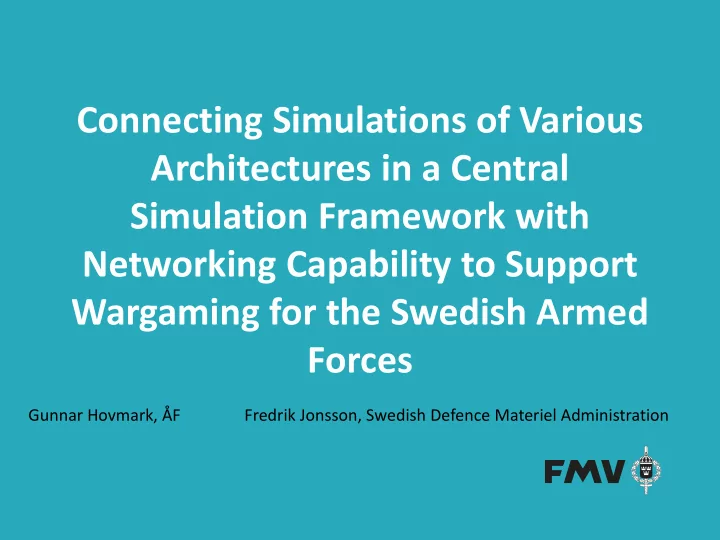

Connecting Simulations of Various Architectures in a Central Simulation Framework with Networking Capability to Support Wargaming for the Swedish Armed Forces Gunnar Hovmark, ÅF Fredrik Jonsson, Swedish Defence Materiel Administration
Presentation overview • Objectives • Simulation system • Models • Simulation example • Networking • Data processing and evaluation • Conclusion
Objectives Provide simulation data to support adjudication in the Swedish Armed Forces defence planning wargaming activities Re-use models and simulations of relevant systems Adapt models and provide simulation support for the focus areas defined by the Swedish Armed Forces Current focus area: Air-to-Air (BVR) scenario
Overview Air-to-Air focus area Acquire and process simulation data to improve adjudication of air defence scenarios Starting with simple scenarios • Air-to-Air (BVR) • Small units, typically one to four aircraft Cooperation with FOI, , the Swedish Defence Research Agency
Central Simulation Framework FLAMES, by Ternion Corporation, Huntsville, Alabama, USA Provides for example • Setup, control and execution of scenarios • Visualization in map view and perspective view • Data logging • Comes with “Bundled models”, full source code for Microsoft Visual Studio 2010, 2013 and 2017
Simulation System Overview Some models and general housekeeping in FLAMES (blue area) Re-used models, often more advanced, run externally
Models High model fidelity • Aircraft • Pilots • Missiles Low model fidelity • Sensors • Countermeasures/EW • Physical environment
Aircraft Models • Based on FLAMES “bundled model” fixed wing aircraft • Aerodynamics and engine data from FMV Technical Intelligence Department (FMV TeknUnd) Turn performance diagram, instantaneous Specific excess and sustained power diagram Altitude Turn rate Nz Mach Example diagrams from open F-16 model
AER table Aircraft Models, ” how to” example CDICL2 • Aerodynamics and engine data converted to CDi/CL^2 sfa Mach och CL: 140317 AER format as published by Saab 2 CL • FLAMES 3DoF “Bundled Model” modified to MACH 0 0 0 0 0.7 0 use data tables 0.1 0 0.1 0.1 0.7 0.15 • Other changes to “Bundled Model” 0.1 1. 0.16 0.1 2.0 0.18 Fuel consumption 0.2 0 0.15 0.2 0.7 0.18 External stores 0.2 1. 0.19 Stall 0.2 2.0 0.12 0.5 0 0.15 Attitude angles 0.5 0.7 0.18 0.5 1.0 0.10 Large heading changes 0.5 1.5 0.09 Time constants 1.0 0 0.12 1.0 0.7 0.15 Limits 1.0 1.0 0.16
Pilot Models Pilot behaviour MCGF by FOI • FMV/FOI component based architecture Merlin • Developed in collaboration with active Extract from behaviour tree fighter pilots description • Behaviour trees defined in XML • “Leaves” defined in C++ • Integrated with FLAMES by FOI • Driven by service in FLAMES • Approximately 3 Hz update rate • Controls aircraft and weapon system via FLAMES commands and queries
Simulation of single shot, generic missile Missile Models, ” Refbib ” • Successfully integrated in various simulations since the 1990s • Updated using data from FMV, FOI and industry • Models defined entirely in FORTRAN, in Linux environment • FORTRAN “wrapper”, called from C in FLAMES to input and extract data to/from missile simulation • Driven by service in FLAMES • 50 Hz update rate
Scenario Controller Configured in FLAMES Command ”Units” window Using commands to set up formations, give them their tasks and launch them Inputs utilize ”Scenario Variables ” than can be Inputs to command set in a number of ways
Typical FLAMES Views
Generic scenario ”ITEC19RedEscort”
Generic scenario ”ITEC19RedEscort”
Generic scenario ”ITEC19RedEscort”
Generic scenario ”ITEC19RedEscort”
Networking with DIS Implemented PDUs (source code available): Entity State Detonation Fire Start/Resume Stop/Freeze Acknowledge
Networking with DIS Encoding, indentifier to enumeration Decoding, enumeration to identifier
Simulation & Evaluation, FOI Work • Experiment files, batch simulations • “Randomness” created by shifting start positions • Data recording in .csv files • Data processing in Excel, MATLAB Line colour: Sim params and/or PostgreSQL Hit Losses Probability Launch Lofted missile trajectory
Data Processing in PostgreSQL GUI in Java/Netbeans to run PostGreSQL queries, for example: • Who detected who first? • Who launched first? • How many missiles were fired? Hit/missed? • How many aircraft were destroyed on each side? Extra, ground attack evaluation using PostGIS: • How many air to ground munitions were launched? • How much of the ground target was destroyed?
Current state and what to do next Available now: • A set of tools that can “easily” be extended to handle new models and scenarios • A set of models • Evaluation tools Next: • Refine extraction and presentation of simulation results • Improve model fidelity
Lessons learned • Modelling and simulation is excellent for improving understanding of dynamic situations • Don’t code everything yourself, always look at the alternatives • Re-use, old code works
Recommend
More recommend